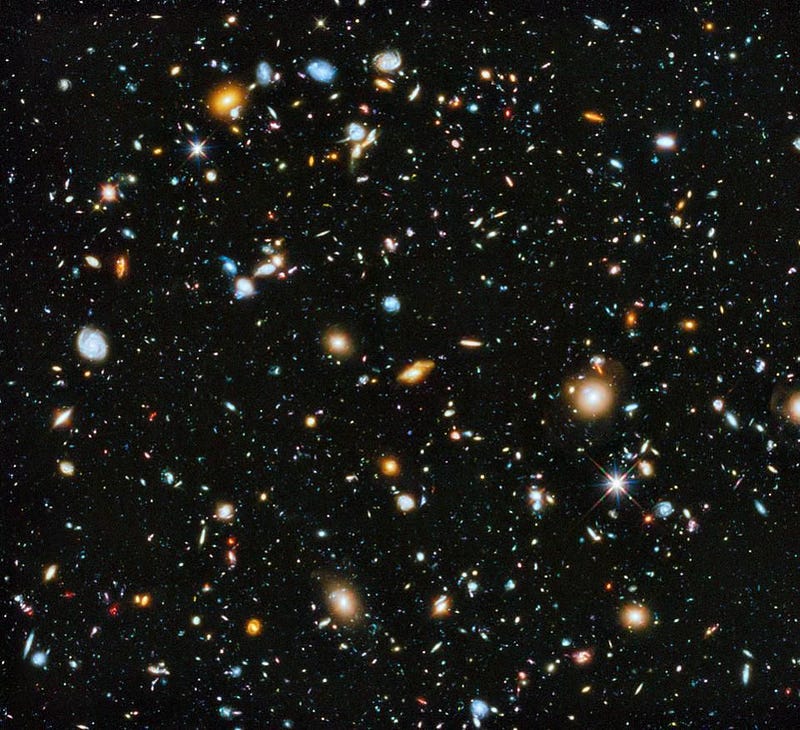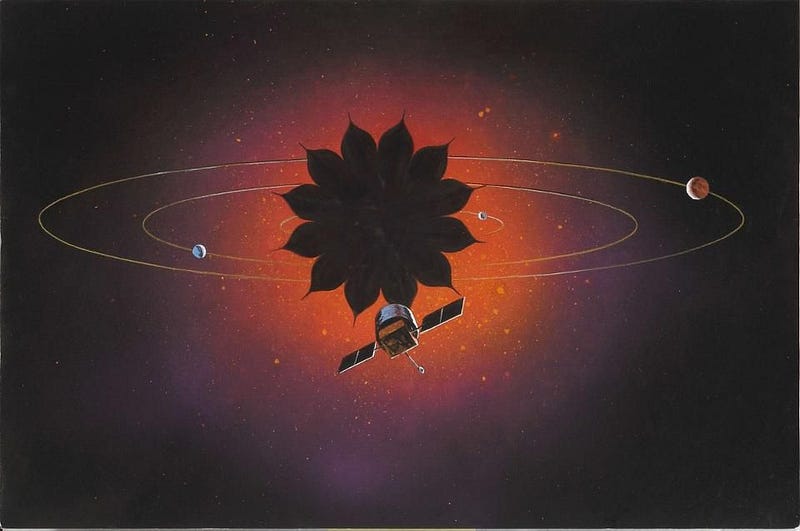Cancelling WFIRST Will Permanently Ruin NASA
There are no punches to pull here. If America believes in science, research, or basic truths about the Universe, we cannot cancel this mission.
Last week, the White House released their plans for the 2018 fiscal year budget. Across many metrics and departments, it was a bloodbath, gutting about $50 billion from agencies focused on science, health, food, arts, humanities, the environment, and education, among many others. But among the reductions was one murderous stroke to NASA: the elimination its flagship mission of the coming decade, WFIRST. The Wide-Field Infrared Space Telescope was chosen by NASA to be the single most important astrophysics mission of the 2020s, and has been in the early planning stages for nearly 20 years. Countless astronomers and astrophysicists have spend their entire professional lives working to make this mission happen, and teach us things we’ll never know, otherwise, about the Universe. Cancelling it is a decision that must be revoked, or NASA will cease to be the leading science and space agency for planet Earth.

There are three major parts to NASA as an agency:
- Science, which encompasses the four major research area NASA is responsible for: astrophysics, planetary science, Earth science, and the study of the Sun.
- Exploration, which includes the development of exploration systems, research and development, and public/private partnerships within the commercial sector.
- and Space Operations, which focuses on astronauts and human-based activity in space, including spaceflight support, the International Space Station, and crewed experiments.
Other components of NASA include aeronautics, space technology, education, as well as the construction, maintenance, operation, and management of both space centers and the agency.

While it’s disastrous for the agency to consider the loss of five of its Earth science missions and the elimination of its office of education, the loss of WFIRST would be an incomparable disaster for the agency. In short, it would declare that NASA no longer will be actively participating in furthering the development of science in these four arenas.
If that seems like a bit of a bold declaration to you, you need to understand how NASA works, and what its purposes are.

When most people think of NASA, they think of this: a literal moonshot. They think about a massive investment in new technologies, including rocketry, crewed spaceflight, exploration, and discovery. This may have been an accurate portrayal of NASA in the 1960s and early 1970s, but since the end of the Apollo program some 45 years ago, this is no longer what NASA looks like. The reason why NASA no longer looks like this is because we stopped investing in it. What was once a small fraction of NASA’s budget is now all that’s left. In its heyday, NASA made up nearly 5% of the federal budget. Today, it makes up less than 0.4%. What we’re talking about cutting are already mere table scraps compared to what our once-thriving space program used to be.

Despite these constraints and the enormous pressure to do so much with so little, NASA has remained synonymous with cutting-edge science and exploration of the great cosmic unknowns. Internally, the Science Mission Directorate, which oversees all four branches of NASA’s science endeavors, has prioritized four different types of mission:
- Small missions: focused on a narrow problem in a particular discipline, these higher-risk, limited-budget missions are cost-effective ways to solve or address a scientific problem within the astrophysics community. An example is NASA’s NICER mission, a small instrument launched to operate on board the ISS, tracking neutron stars and measuring their timing, interiors, and other properties.
- Medium missions: focusing on a larger problem with a mid-size budget, these missions are lower-risk and are focused on serving a wide swath of the science community, often providing the majority of data for a particular sub-field. NASA’s TESS mission, launching next month, is a great example of a mid-size mission to serve the exoplanet community.
- Large missions: only low-risk, high-priority missions can be found here. A stunning example of the incredibly rich science that can come back from such a mission is NASA’s New Horizons, which flew by Pluto in 2015 and is headed onto its next target, after teaching us more about Kuiper belt objects than we’d ever imagined we’d learn.
- Flagship missions: these are civilization-scale science missions of national or global importance. These missions are both the most expensive and the most rewarding, in terms of science and societal impact, of anything NASA does. The Hubble Space Telescope is the most well-known example of a flagship missions, having forever changed how we view the Universe.

According to Thomas Zurbuchen, Associate Administrator for the Science Mission Directorate of NASA:
What we learn from these flagship missions is why we study the Universe. This is civilization-scale science… If we don’t do this, we aren’t NASA.
This was a statement he made just last month at NASA’s Town Hall at the American Astronomical Society’s annual meeting. WFIRST was selected as the #1 overall mission for the 2020s back in 2010; it’s a mission that takes approximately 15 years to design, contract, execute, build, deliver, and launch. In terms of science, it planned to primarily serve a number of major communities within astronomy and astrophysics: supernova research, extragalactic astronomers, exoplanet researchers, studies of the galactic center, and wide-field studies that focus on gravitational lensing and properties of the cosmic web.

The way it’s poised to do this is by taking a telescope that’s similar in optical properties to Hubble, but by outfitting it with all-new instruments optimized for a wide-field view of the Universe. Instead of being limited to a narrow slice of the Universe, WFIRST could image it just as deeply as Hubble, except 60 times as quickly. The “WF” stands for Wide-Field for a reason; the amount of Universe it can image is huge! And as a result, the amount we can learn about the Universe is huge as well.
Some of our greatest existential questions would be answered by WFIRST. How does dark energy behave, for example? Does it evolve over time? Is it uniform in all directions? Do the results from supernovae, the cosmic web, and extragalactic signals all point to the same set of properties? WFIRST would answer all of these questions as no other mission, past, present, or even proposed, would be capable of.

In 2010, the National Research Council’s Astronomy and Astrophysics Decadal Survey made WFIRST the top priority recommendation in the large space mission category. They also made a recommendation that they add on significant capabilities for exoplanet studies, including a state-of-the-art coronagraph, and those are being implemented. By monitoring a large sample of stars in the Milky Way’s center, WFIRST will allow us to detect, via subtle changes in brightness, the presence of exoplanets that NASA’s Kepler could never have seen. We will learn how common Earth-like planets are around a wide variety of stars and over a very large range of orbital parameters.

In addition, like all such flagship missions, including Hubble and James Webb, there will be a guest observer program. Not only will research in galactic, extragalactic, exoplanet, gravitational lensing, baryon acoustic oscillation and supernova sub-fields be considered, but any astrophysical topic that could take advantage of WFIRST’s unique capabilities can propose. This is poised to be the leading observatory for a wide slew of purposes for not just a few years, but — like Hubble — potentially for decades.
It was the top choice out of all the missions that the entire astronomy and astrophysics community proposed. It represented a huge effort in collaboration between groups with widely disparate interests and passions, and allowed cosmologists and exoplanet scientists to work together on putting together a mission that these non-overlapping communities could both benefit from. It included the possibility of a starshade, which would enable planet-finding and measurement to an unprecedented level.

And with a nuclear stroke from the Trump administration, it all threatens to crumble away. The entire justification given by the Trump administration was as follows:
Development of the WFIRST space telescope would have required a significant funding increase in 2019 and future years, with a total cost of more than $3 billion. Additionally, a recent independent review concluded that WFIRST was not executable within its previous budget. Given competing priorities at NASA, and budget constraints, developing another large space telescope immediately after completing the $8.8 billion James Webb Space Telescope is not a priority for the Administration. The Budget proposes to terminate WFIRST and redirect existing funds to other priorities of the science community, including completed astrophysics missions and research.
The administration can set whatever priorities it likes for itself, but humanity deserves a space program we can be proud of. We deserve one where scientists, working together over the span of decades, can set their own priorities for what is scientifically valuable. For the (current) 2018 fiscal year, the House and Senate both requested additional funds for WFIRST, recognizing its national importance and even demanding an additional $20M to investigate the feasibility of a starshade.

We absolutely cannot let this project go down without a fight. If WFIRST gets cancelled, it’s a sign that even the most important NASA project, as determined by internal, external, and independent reviewers, is subject to political whims. These projects take more than a single presidency to design, approve, build, and launch. Federal funding for these vital missions that enhance all of society must not be allowed to disappear because one human — even if it’s the president — wills it. The joys, wonder, knowledge, and benefits that come from exploring and understanding the Universe are greater than any individual.
25 years ago, the Superconducting Supercollider (SSC) was cancelled, and today, the United States doesn’t even have a major particle physics facility in the same league as the LHC at CERN, which is itself a vastly inferior machine to what the SSC would have been. The United States must not cede leadership in the space and science arena to Japan, Russia, Europe, China, India and Canada in the same way. Humanity’s capability of understanding the entire Universe is at stake.
Ethan Siegel is the author of Beyond the Galaxy and Treknology. You can pre-order his third book, currently in development: the Encyclopaedia Cosmologica.





